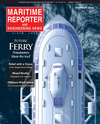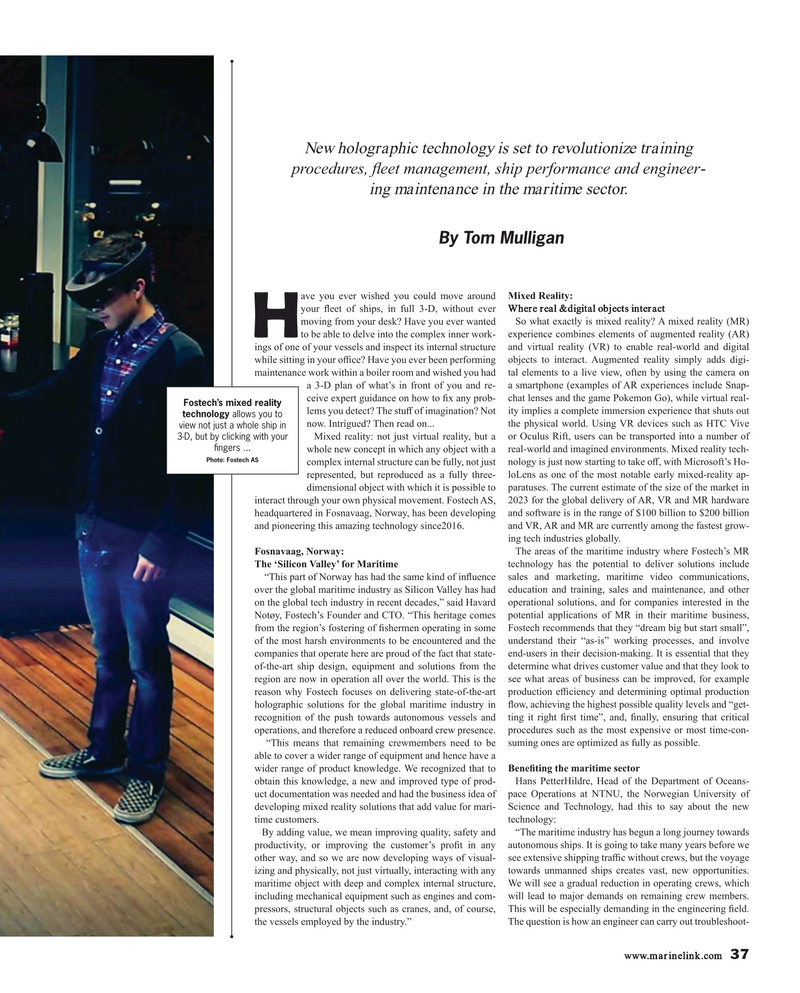
Page 37: of Maritime Reporter Magazine (February 2019)
Ferry Builders
Read this page in Pdf, Flash or Html5 edition of February 2019 Maritime Reporter Magazine
New holographic technology is set to revolutionize training procedures, feet management, ship performance and engineer- ing maintenance in the maritime sector.
By Tom Mulligan ave you ever wished you could move around Mixed Reality: your feet of ships, in full 3-D, without ever Where real &digital objects interact moving from your desk? Have you ever wanted So what exactly is mixed reality? A mixed reality (MR)
Hto be able to delve into the complex inner work- experience combines elements of augmented reality (AR) ings of one of your vessels and inspect its internal structure and virtual reality (VR) to enable real-world and digital while sitting in your ofce? Have you ever been performing objects to interact. Augmented reality simply adds digi- maintenance work within a boiler room and wished you had tal elements to a live view, often by using the camera on a 3-D plan of what’s in front of you and re- a smartphone (examples of AR experiences include Snap- ceive expert guidance on how to fx any prob- chat lenses and the game Pokemon Go), while virtual real-
Fostech’s mixed reality lems you detect? The stuf of imagination? Not ity implies a complete immersion experience that shuts out technology allows you to now. Intrigued? Then read on... the physical world. Using VR devices such as HTC Vive view not just a whole ship in
Mixed reality: not just virtual reality, but a or Oculus Rift, users can be transported into a number of 3-D, but by clicking with your fngers ...
whole new concept in which any object with a real-world and imagined environments. Mixed reality tech-
Photo: Fostech AS complex internal structure can be fully, not just nology is just now starting to take of, with Microsoft’s Ho- represented, but reproduced as a fully three- loLens as one of the most notable early mixed-reality ap- dimensional object with which it is possible to paratuses. The current estimate of the size of the market in interact through your own physical movement. Fostech AS, 2023 for the global delivery of AR, VR and MR hardware headquartered in Fosnavaag, Norway, has been developing and software is in the range of $100 billion to $200 billion and pioneering this amazing technology since2016. and VR, AR and MR are currently among the fastest grow- ing tech industries globally.
Fosnavaag, Norway: The areas of the maritime industry where Fostech’s MR
The ‘Silicon Valley’ for Maritime technology has the potential to deliver solutions include “This part of Norway has had the same kind of infuence sales and marketing, maritime video communications, over the global maritime industry as Silicon Valley has had education and training, sales and maintenance, and other on the global tech industry in recent decades,” said Havard operational solutions, and for companies interested in the
Notøy, Fostech’s Founder and CTO. “This heritage comes potential applications of MR in their maritime business, from the region’s fostering of fshermen operating in some Fostech recommends that they “dream big but start small”, of the most harsh environments to be encountered and the understand their “as-is” working processes, and involve companies that operate here are proud of the fact that state- end-users in their decision-making. It is essential that they of-the-art ship design, equipment and solutions from the determine what drives customer value and that they look to region are now in operation all over the world. This is the see what areas of business can be improved, for example reason why Fostech focuses on delivering state-of-the-art production efciency and determining optimal production holographic solutions for the global maritime industry in fow, achieving the highest possible quality levels and “get- recognition of the push towards autonomous vessels and ting it right frst time”, and, fnally, ensuring that critical operations, and therefore a reduced onboard crew presence. procedures such as the most expensive or most time-con- “This means that remaining crewmembers need to be suming ones are optimized as fully as possible.
able to cover a wider range of equipment and hence have a wider range of product knowledge. We recognized that to Benefting the maritime sector obtain this knowledge, a new and improved type of prod- Hans PetterHildre, Head of the Department of Oceans- uct documentation was needed and had the business idea of pace Operations at NTNU, the Norwegian University of developing mixed reality solutions that add value for mari- Science and Technology, had this to say about the new time customers. technology:
By adding value, we mean improving quality, safety and “The maritime industry has begun a long journey towards productivity, or improving the customer’s proft in any autonomous ships. It is going to take many years before we other way, and so we are now developing ways of visual- see extensive shipping trafc without crews, but the voyage izing and physically, not just virtually, interacting with any towards unmanned ships creates vast, new opportunities. maritime object with deep and complex internal structure, We will see a gradual reduction in operating crews, which including mechanical equipment such as engines and com- will lead to major demands on remaining crew members. pressors, structural objects such as cranes, and, of course, This will be especially demanding in the engineering feld. the vessels employed by the industry.” The question is how an engineer can carry out troubleshoot- www.marinelink.com 37

 36
36

 38
38
